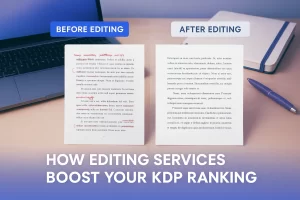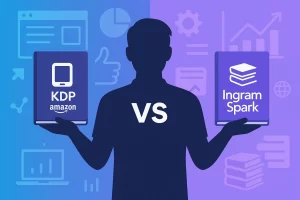Suppose you are managing a traditional publishing firm, but facing several publishing hassles that cause barriers in executing a smooth publishing process. Prolonged publishing process, low acceptance rates, along with limited royalties and lack of creative control, compel traditional publishers to adapt and innovate their business models to survive in the digital landscape. From cylinder seals to woodblock printing to hand-operated presses and the introduction of color printing and mechanical typesetters, the modern publishers revolutionized the book production, design, publishing, and distribution process.
Adapting a digital publishing model allows traditional publishing companies to employ self-publishing that gives complete control to publishers to create, design, and publish manuscripts. With digitalization, modern publishing houses have begun utilizing AI publishing technologies that democratize the publishing workflow. The automated AI content generation tool, which includes natural language processing (NLP), assists authors in creating a book outline, description, plot, and setting. AI- editing and proofreading tools find and fix syntax and grammatical errors, refine style, and improve book design, illustration, and layout. AI-powered marketing tools, incorporating machine learning and predictive analytics, help publishers engage with market research, trend analysis, and campaign creation. AI-targeted marketing analyzes readers’ data to identify niche audiences’ reading choices and trends and launches the marketing campaigns through email, social media, and websites. Newsletters, social media ads, and an AI algorithm for SEO content marketing increase book visibility on Amazon and bring higher organic engagement and conversion rates.
Another significant impact of AI is the massive production of digital-format books. AI tools offer convenience and quick access to publishers to generate a complete manuscript and also easily convert files into print and digital formats, including EPUB, Mobi, and PDF. Digital publishing technology, encompassing e-readers, tablets, and smartphones, has brought instant access to readers to download a variety of e-books. The electronic book readers are portable and compact, and store countless digital books in a single device, and can be carried with ease.
To format the book like a pro before publishing implies that self-publishing authors utilize online publishing sites such as Amazon Kindle Direct Publishing. The digital publishing platforms instantly create, format, market, and sell books globally through a Print-on-Demand service. The cost-effective publishing mode eliminates the printing and warehouse costs as it prints a single or multiple copies based on the client’s order. POD service also ensures prompt dispatch of printed manuscripts to the clients. AI book distribution tools with predictive analytics anticipate future book sales, adjust prices in real-time, manage royalties, and increase ROI.
So, whether you are an independent publisher or managing your publishing company and planning to grow your book publishing and printing businesses in both local and international markets, reading this informative blog helps you explore AI’s role in content creation and publishing. You will learn how digital innovations such as the integration of Artificial Intelligence, machine learning, and predictive analytics have streamlined manuscript editing, cover design, and the publishing process, making it smoother and more convenient for authors and publishers. Further reading of the blog helps book marketers understand how to utilize AI-driven tools for book marketing, advertising, and distribution that maximize book reach and accessibility.
Section 1: AI in Editing – From First Draft to Final Polish
1.1. Automated Grammar & Style Checking
An indie author either self-edits the book or hires specialized editing services to conduct transparent and rigorous editing. Experienced authors and professional editors at book writing services utilize high-functioning book editing software such as Scrivener, ProWritingAid, Grammarly, and the Hemingway Editor to improve syntax, vocabulary, and content readability.
To bring clarity, flow, and accuracy in the text, Hemingway Editor highlights complex phrases, redundant words, and grammatical issues. Moreover, AI-powered software detects passive voice and adverbs to create simple and comprehensible content easily grabbed by readers.
The editors use ProWritingAid software for copyediting. It involves deeply analyzing different aspects of the book. The user-friendly interface enables editors to analyze pacing, flow, and syntax errors in the paragraph. The tool explores inconsistencies in characters, scenes, and settings, such as abrupt changes in backstory or descriptive details that make readers lose momentum in reading. With AI editing assistance, the experts enrich the narrative tone by building internal conflict, character arc, and climax. Improving the storyline and other elements increases thrill and suspense. A compelling voice and tone of the chapters deeply immerse readers, building an emotional connection with the story.
Grammarly assists the publishing manager with complete book editing from the initial phase of editing to the final stage of refining and polishing the content and structure. AI-driven software catches typos, grammatical, and punctuation errors. Reorganizes the chapters and sections by removing inappropriate details, overused words, adverbs, or adjectives within the text. Moreover, rephrasing the text and adding missing transitions develops coherence between the sections and helps enhance the style and tone of the narrative.
AI book formatting software, comprising Vellum and Atticus, and Scrivener, assists in quick manuscript organization. It includes adjusting consistent fonts, proper margins, paragraph spacing, text alignment, and page numbering. Adding a table of contents with chapter headings and their consistent page numbers, and inserting a preface, title page that displays the book title, author’s name, publisher’s information, and ISBN. At the end, they add a glossary, index, and bibliography. The formatting tools export the file to print and e-book format, along with creating a striking book layout design. Overall, the authors, editors, and book designers use AI formatting to create high-quality and error-free printed manuscripts and e-books with compelling interior book layouts.
1.2. AI-Powered Developmental Editing
Whether an author intends to self-publish or traditionally publish the manuscript, they may seek professional editing and proofreading assistance from top-notch editing experts at David McKay Publications. They offer outstanding editing services that involve a smooth and professional editing process based on multiple editing stages. While engaging in developmental editing, the editorial experts study the manuscript’s big picture, including the plot, character development, pacing, and improving the overall narrative consistency and flow. Furthermore, development editors utilize AI-specialized editing tools to professionally review and improve the structure of the book. An executive editor employs Plottr, Sudowrite, and ChatGPT, software that identifies the key plot points and ensures that the plot events have logical consistency.
The tools evaluate character arcs, growth, and transformation of the characters within the narrative. Regarding assessing the pace in the paragraphs, AI tools build coherence and flow in the chapters by adding a sequence of events or scenes. Balancing action with dialogue and exposition increases the pace of the overall narrative.
The editing tools effectively analyze the theme of the manuscript and ensure that the key idea conveyed in the narrative is consistent and blends with the author’s tone and voice. Consistency in narrative style and tone increases the audience’s interest and makes readers captivated throughout the book.
1.3. The Human-AI Collaboration
The publishing supervisor at David McKay Publications utilizes human and AI collaboration in extensive manuscript editing. Understanding the editor’s role as a creative decision-maker, the team of editors exercises their creative input while conducting copyediting, substantive editing, and developmental editing. They evaluate the book from different angles and provide recommendations and logical judgment to improve the structure, plot, settings, characterization, tone, and style of the manuscript. Reviewing the initial draft involves editors focusing on improving the structure and building narrative flow that makes the content appealing to the readers. Using their editorial judgment, the reviewer analyzes the plot holes and narrative inconsistencies. To strengthen the plot, the copyeditors suggest modifying the character’s motivation, behavior, and style to create relatable characters. They add sensory details to develop powerful scenes and settings and develop inspiring character voices that keep readers enticed. The editors uphold ethical standards and ensure quality control during the editing and proofreading phase. The experts prevent unethical practices and detect plagiarized and misleading content. Thus, they prepare a professionally edited and formatted manuscript that adheres to industry-wide standards for clarity, consistency, and premium publishing standards.
Adapting a hybrid approach of combining AI’s efficiency and an editor’s intuition, professional book publishing services utilize AI’s processors for quick and efficient book editing, formatting, and designing. The AI editing tools speedily review the entire manuscript and fix minor errors such as typos, grammar and punctuation errors, pacing, and other formatting flaws that are overlooked by the editor. Moreover, the tools also effectively cover the ethical issues in the content by identifying plagiarized content. Additionally, they suggest recommendations to create an original masterpiece that boosts readability.
The integration of human and AI capabilities during the pre-production and editing phase handles complex flaws in content and structure. The final phase of proofreading involves AI tools offering automated checks in identifying grammar, spelling, and punctuation errors in real-time. The suggestions help editors in refining the text for clarity, style, and consistency.
The hybrid approach further assists in the post-production of the published books. It includes quality improvements in book cover designs and book layout. AI tools help in book marketing, such as creating marketing campaigns for websites and social media. AI-driven marketing tools generate ads that run on Google and Amazon. AI optimizes content for search engines that increase book discoverability on Amazon. With AI distribution tools, both printed and digital format books are disseminated broadly.
Section 2: AI in Cover Design – Turning Data into Visuals
AI-Assisted Creativity in Book Cover Designs
Book Writing Services leverages AI design tools to create stunning front and back book cover designs, images, and layouts. The designers create text prompts related to book genre, theme, characters, and other elements. Based on these text descriptions, the AI tools generate images and designs for the book cover and interior layout. Prominent AI design tools modify the design process by delivering multiple layout options, color palettes, and typography that blend with the book’s genre and theme.
The renowned AI book cover design software, such as Midjourney, creates and designs artistic book covers, high-resolution images, and other customizable elements using text prompts. A powerful engine helps authors and designers to conduct brainstorming and develop unique ideas for book cover design. The designers utilize their artistic ideas, complex concepts, or atmospheric moods to develop design prompts. The AI tool visualizes the cover design and quickly creates artistic covers, adding creative graphics, color patterns, and topography. Striking UI designs hit the targeted market and bring high book sales and revenue.
Canva, another AI design software, includes design templates covering over 1 million stock images and illustrations. The design models available in the library help designers to create professional book covers.
DALL·E is the latest AI image tool comprising deep learning techniques and natural language. Like other AI algorithms, this design model also allows developers to send a textual prompt to design high-resolution, hyper-realistic images for historical and scientific fiction. The AI model also processes complex prompts to design aesthetically pleasing book layouts and develop coherent images to craft eye-catching book covers.
Adobe Firefly, integrating with Adobe Express and other Creative Cloud applications, generates a book cover image based on the prompt that illustrates the style, color, typography, and custom text effects. Thus, AI-generated immersive book cover designs with artistic designs and textual effects capture readers ‘interest in purchasing their copy from physical bookstores or online retailers.
AI Design Tools Analyze Reader Data to Create Alluring Cover Designs
Book writing services employ AI book cover software to produce impressive book covers. Vibrant colors and striking imagery in exclusive covers help boost the market demand of the published manuscript. With AI tools, the designers analyze the changing demands of consumers. The reader data received allows designers to know which cover designs attract the buyers the most. They learn. The designers modify cover designs and adjust the color palettes for different genres of books. For instance, dark colors such as black and red are used to create book covers for mystery and thriller fiction. Book covers for romantic and fantasy novels include soft, light color patterns like pink, purple, white, and blue. Light typography in book layout evokes emotional response in the readers, such as bringing serenity, ecstasy, and warmth.
An appealing artistic cover based on current market trends and audience preferences significantly attracts potential buyers. As more readers click on the site, it increases click-through rates and increases book discoverability on online stores. Hence, the design tools such as Canva or Adobe Express generate numerous design patterns more quickly, along with integrating striking color patterns, typography, imagery, graphics, and other visual cues as compared to traditional design methods.
Section 3: AI in Marketing – Smarter Strategies, Stronger Sales
Personalized Book Recommendations
Self-publishing authors utilize the Amazon and Goodreads platforms to boost personalized recommendations and increase their books’ visibility on online platforms. AI book recommendation systems employed by Amazon and Goodreads classify readers based on similar reading habits, behavior, and preferences. AI-driven collaborative filtering systems evaluate the ratings and reviews submitted by the readers regarding the books they have read. The tools connect readers with similar reading preferences and then recommend books from the same category to them. Content-based filtering involves machine learning and NLP technology that analyzes book features, genre, themes, author’s writing style, and plot points. Based on reading choices. The tools offer personalized recommendations, suggesting new books with similar attributes.
Many book writing services use hybrid and advanced approaches for personalized book recommendations. It includes integrating both collaborative and content-based filtering to provide wide-ranging book reading suggestions to readers. Employing machine learning and deep learning models, the tools analyze the existing and changing reading trends of the potential audience. The publishers highlight the emerging trends in reading, allowing readers to gain a unique reading experience.
Book publishers also increase book discoverability by building connections with influencers, industry professionals, literary communities, libraries, and book-reading platforms. Forming an author platform allows writers to join writing forums and interact with potential readers through the author’s website, emails, and social media following. Building links with a global audience increases book discoverability and also boosts the author’s publication rating widely.
AI in Advertising & Targeting
The publishing team at David Mckay Publications employs various AI marketing and advertising tools to create compelling ad marketing campaigns that increase engagement and boost manuscript visibility on physical bookstores and online retailing sites.AI algorithms allow marketers to analyze the cost of publishing a book in 2025. The marketing campaign cost varies depending on the selected publishing route, extensive marketing strategies, upfront cost, and royalties.
The marketing experts employ BookBub for book promotion. A self-serve, auction-based advertising platform markets the books by displaying book covers and running ads on BookBub’s website. BookBub Ads with machine learning and predictive analytics assess the audience’s reading patterns and choices, and choose fans or BookBub followers who have similar reading trends. CPM ads appear regularly in BookBub’s newsletters and website. The ads include featured deals that promote various authors’ books to boost book sales. Running these ads helps new authors expand book reach among a vast audience.
Facebook and Instagram ads help in promoting the author’s publication in a broad book market. The marketing experts employ advanced AI tools to create striking ad visuals that display attractive book cover images, videos, podcasts, and stories. Moreover, integrating graphics and animation optimizes ad visuals that create buzz around the book, capturing more audience attention.
Amazon’s ads promote books directly to the online bookstore. Sponsored product ads appear on product detail pages. The authors, having a wide list of published books, use sponsored brand ads. The ads display the published titles along with impressive book images and videos. The Amazon publishing team employs lock screen ads that appear on Kindle devices and tempt Kindle readers to purchase their preferred manuscript.
Content Creation & Social Media Automation
Book publishing services leverage AI content creation and social media automation tools to boost book marketing on different social media channels. Social media marketing tools comprising machine learning and generative AI to develop marketing campaigns for Facebook, Instagram, and YouTube. The marketing plan includes creating scheduled social media posts with engaging text, headings, and visuals. The post creates awareness in the audience by displaying book features and its reading impact on readers. Moreover, AI tools create impactful marketing content, including blogs, feature articles, and newsletters integrated with book covers, book trailers, and images that increase book promotion on social media. AI also assists in crafting compelling hashtags that increase social media followers. The tools track reader engagement across various digital channels. It allows marketers to know the effectiveness of the launched marketing campaigns on different social media platforms and modify their campaigns to boost reader engagement.
Reader Engagement & Chatbots
AI-powered chatbots and personalized newsletters have emerged as innovative tools to create targeted communication with potential customers. AI Chatbots with machine learning, natural language processing (NLP), and large language models (LLMs) recognize customer intent, gather data, and interact with consumers in real time. They provide instant responses to users’ queries and feedback on websites and social media, and review sites. AI assistants interact and resolve issues related to book recommendations, book pricing, and the online purchasing process. AI newsletter and email marketing platforms create marketing content based on a subscriber’s interests and engagement with the author’s publication. AI helps publishers in crafting engaging newsletters comprising featured articles, blog posts, interesting book descriptions, book covers, and images that promote the printed and e-book versions on physical retailers and online stores.
Section 4: Challenges & Ethical Considerations
Though professional book publishing services employ AI tools for smooth and reliable book publishing, marketing, and distribution; however, there are certain challenges and ethical considerations that publishers encounter. Writers utilize AI content generation tools such as ChatGPT, Writesonic, and NovelAI for writing a fiction or non-fiction book. Based on the provided prompts, the tools gather relevant material. AI-generated content derived from vast datasets lacks sensory perception, emotions, and cultural context.
Another issue publishing houses encounter is data bias. Since AI systems work with programmed algorithms and rely on different datasets to accumulate data, it might be possible that the material lacks transparency. The data covers biased or inappropriate personal information that leads to discriminatory outcomes. AI content is formed through reproducing different writing styles; therefore, it lacks originality and fails to interpret truth and accuracy. The rising transparency and accountability issues in AI content creation increase the risk of data breaches. The black box problem in complex AI models using deep learning is vague. Their data collection involves unauthorized sources that are challenging for publishers to identify the reliable of AI content.
To identify inconsistent information and forged sources, the publishing services are liable to conduct continuous auditing of AI content. Developers, policymakers, book publishers, and authors are required to work together to improve the quality of AI content. AI researchers, engineers, and data scientists further assist in developing the core algorithms. The researchers explore new training methodologies, such as integrating AI outputs with human perspective and judgment. Data scientists get involve with authentic data analysis to prepare transparent datasets to train AI models. AI engineers develop high-functioning AI models that generate high-quality content based on wide-ranging genres and fields.
Recapitulate
Digital transformation gave rise to self-publishing platforms that benefited independent authors and publishers. Self-publishing houses gained creative autonomy in printing, marketing, and distribution of manuscripts. To make self-publishing more accessible and efficient, indie authors are employing AI tools that assist them throughout the publishing process. AI assistants facilitate writers with pre-writing and research. The content creation AI-driven tools, such as OpenAI’s GPT, and AI-powered chatbots and virtual assistants, gather relevant material to craft high-quality content that resonates with audience choices and interests. Self-published authors use AI editing tools such as Grammarly, ProWritingAid, and Hemingway Editor for comprehensive manuscript editing and proofreading. AI tools with an advanced grammar-checker identify grammatical and syntax errors in the text and provide suggestions to enrich the content style. AI design tools help create stunning book cover designs and book layouts.
The machine learning algorithm with search functionality makes book discoverability convenient on Amazon. The tools assist authors in crafting smart and relevant keywords, book titles, and metadata book descriptions. AI book distribution tool optimizes supply chain and distribution processes, ensuring that the printed manuscripts are easily accessible to a worldwide audience. The publishers use AI tools to analyze sales data to adjust prices in real-time, and bring high sales volume and revenue. AI-generated social media marketing campaigns include posting social media content, visuals, and images on different channels to boost readership. AI also develops other promotional materials, such as book blurbs, ad copy, and newsletters that increase brand awareness. Apart from facilitating new publishers to make informed decisions related to book publishing, marketing, and prompt distribution of books, the advanced AI publishing tools help publishers analyze competitor pricing and set appropriate pricing strategies to attract extensive customers. They automate publishing workflow, enhance creative processes, and offer personalized recommendations to a vast audience. AI anticipates the changing market trends, enabling new self-publishers to adapt to the latest publishing trends and expand their book marketing on different digital touchpoints.




